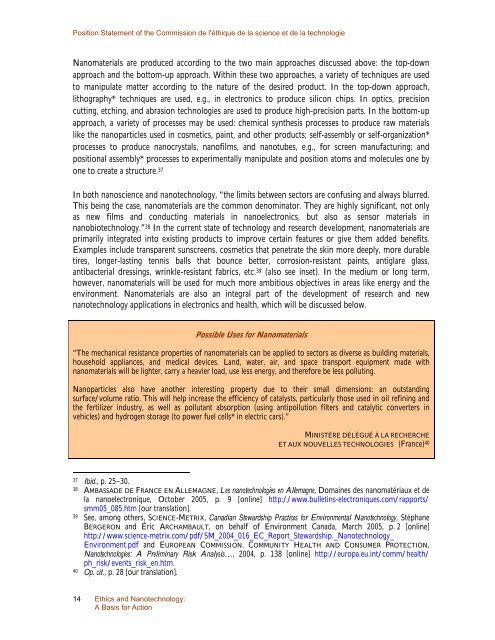A Basis for Action - Commission de l'éthique de la science et de la ...
A Basis for Action - Commission de l'éthique de la science et de la ...
A Basis for Action - Commission de l'éthique de la science et de la ...
Create successful ePaper yourself
Turn your PDF publications into a flip-book with our unique Google optimized e-Paper software.
Position Statement of the <strong>Commission</strong> <strong>de</strong> l'éthique <strong>de</strong> <strong>la</strong> <strong>science</strong> <strong>et</strong> <strong>de</strong> <strong>la</strong> technologie<br />
Nanomaterials are produced according to the two main approaches discussed above: the top-down<br />
approach and the bottom-up approach. Within these two approaches, a vari<strong>et</strong>y of techniques are used<br />
to manipu<strong>la</strong>te matter according to the nature of the <strong>de</strong>sired product. In the top-down approach,<br />
lithography* techniques are used, e.g., in electronics to produce silicon chips. In optics, precision<br />
cutting, <strong>et</strong>ching, and abrasion technologies are used to produce high-precision parts. In the bottom-up<br />
approach, a vari<strong>et</strong>y of processes may be used: chemical synthesis processes to produce raw materials<br />
like the nanoparticles used in cosm<strong>et</strong>ics, paint, and other products; self-assembly or self-organization*<br />
processes to produce nanocrystals, nanofilms, and nanotubes, e.g., <strong>for</strong> screen manufacturing; and<br />
positional assembly* processes to experimentally manipu<strong>la</strong>te and position atoms and molecules one by<br />
one to create a structure. 37<br />
In both nano<strong>science</strong> and nanotechnology, “the limits b<strong>et</strong>ween sectors are confusing and always blurred.<br />
This being the case, nanomaterials are the common <strong>de</strong>nominator. They are highly significant, not only<br />
as new films and conducting materials in nanoelectronics, but also as sensor materials in<br />
nanobiotechnology.” 38 In the current state of technology and research <strong>de</strong>velopment, nanomaterials are<br />
primarily integrated into existing products to improve certain features or give them ad<strong>de</strong>d benefits.<br />
Examples inclu<strong>de</strong> transparent sunscreens, cosm<strong>et</strong>ics that pen<strong>et</strong>rate the skin more <strong>de</strong>eply, more durable<br />
tires, longer-<strong>la</strong>sting tennis balls that bounce b<strong>et</strong>ter, corrosion-resistant paints, antig<strong>la</strong>re g<strong>la</strong>ss,<br />
antibacterial dressings, wrinkle-resistant fabrics, <strong>et</strong>c. 39 (also see ins<strong>et</strong>). In the medium or long term,<br />
however, nanomaterials will be used <strong>for</strong> much more ambitious objectives in areas like energy and the<br />
environment. Nanomaterials are also an integral part of the <strong>de</strong>velopment of research and new<br />
nanotechnology applications in electronics and health, which will be discussed below.<br />
Possible Uses <strong>for</strong> Nanomaterials<br />
“The mechanical resistance properties of nanomaterials can be applied to sectors as diverse as building materials,<br />
household appliances, and medical <strong>de</strong>vices. Land, water, air, and space transport equipment ma<strong>de</strong> with<br />
nanomaterials will be lighter, carry a heavier load, use less energy, and there<strong>for</strong>e be less polluting.<br />
Nanoparticles also have another interesting property due to their small dimensions: an outstanding<br />
surface/volume ratio. This will help increase the efficiency of catalysts, particu<strong>la</strong>rly those used in oil refining and<br />
the fertilizer industry, as well as pollutant absorption (using antipollution filters and catalytic converters in<br />
vehicles) and hydrogen storage (to power fuel cells* in electric cars).”<br />
MINISTÈRE DÉLÉGUÉ À LA RECHERCHE<br />
ET AUX NOUVELLES TECHNOLOGIES (France) 40<br />
37 Ibid., p. 25–30.<br />
38 AMBASSADE DE FRANCE EN ALLEMAGNE, Les nanotechnologies en Allemagne, Domaines <strong>de</strong>s nanomatériaux <strong>et</strong> <strong>de</strong><br />
<strong>la</strong> nanoelectronique, October 2005, p. 9 [online] http://www.bull<strong>et</strong>ins-electroniques.com/rapports/<br />
smm05_085.htm [our trans<strong>la</strong>tion].<br />
39 See, among others, SCIENCE-METRIX, Canadian Stewardship Practices <strong>for</strong> Environmental Nanotechnology, Stéphane<br />
BERGERON and Éric ARCHAMBAULT, on behalf of Environment Canada, March 2005, p. 2 [online]<br />
http://www.<strong>science</strong>-m<strong>et</strong>rix.com/pdf/SM_2004_016_EC_Report_Stewardship._Nanotechnology_<br />
Environment.pdf and EUROPEAN COMMISSION. COMMUNITY HEALTH AND CONSUMER PROTECTION,<br />
Nanotechnologies: A Preliminary Risk Analysis…, 2004, p. 138 [online] http://europa.eu.int/comm/health/<br />
ph_risk/events_risk_en.htm.<br />
40 Op. cit., p. 28 [our trans<strong>la</strong>tion].<br />
14 Ethics and Nanotechnology:<br />
A <strong>Basis</strong> <strong>for</strong> <strong>Action</strong>
















